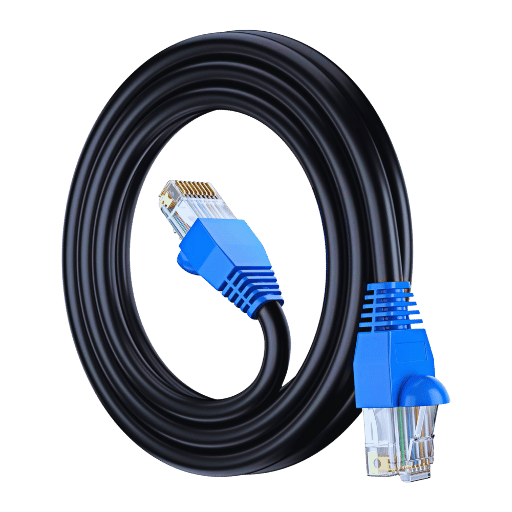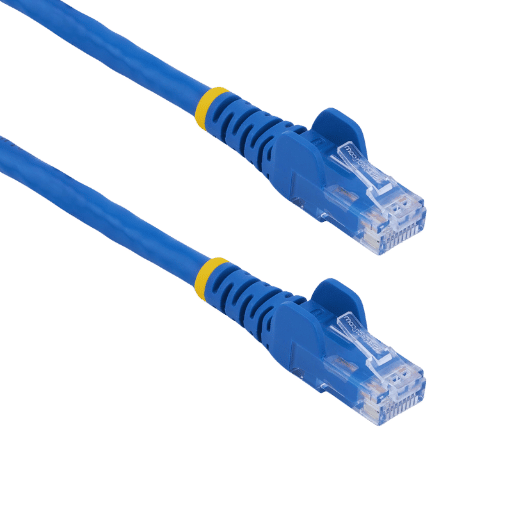In today’s world that is controlled by technology, it is vital to have an internet connection that can be depended on for personal and work activities. Ethernet cables are responsible for creating a stable and fast network connection, thus making them basic components when setting up home or office networks. This article provides detailed information about 25 ft Ethernet cables, including their main features, performance capabilities, and areas of application. We want to help our readers choose the right cable among different options available in the market so as to ensure smooth connectivity at all times. The knowledge about Ethernet cables’ specifics can greatly improve your network performance whether you are streaming content online, playing games, or running a business from home.

An ethernet cable is a network cable for wired connections between devices like computers, routers, and switches. A 25 ft Ethernet cord provides a standard length, which allows you to place it anywhere you want yet still maintain a good connection. It is necessary for high-speed data transfer with low latency, thus making this ideal for stable internet access, which is required in applications like video conferencing or online gaming. The cables usually have twisted pair wiring, and there are different types (e.g., Cat5e and Cat6) that show how well they can perform in terms of bandwidth and speed.
A 25 ft Ethernet cable has many good points that can help improve network performance and usability. First, this length is enough to connect devices that are far away from routers or switches, thereby reducing the need for more extenders or complicated layout plans. Second, wired connections made through Ethernet cables are more stable and faster than wireless ones, which may suffer from interference or signal degradation. This is especially useful when performing tasks that require large amounts of data to be transferred reliably, such as online gaming, HD streaming, or file sharing, among others. Moreover, these cables are relatively cheap; hence, they provide a cost-effective solution for building strong network infrastructures. Lastly, easy installation and maintenance foster neatness in work areas, thus enhancing productivity.
The 25-foot-long Ethernet cables are very flexible and can be used in many networking environments. For example, at home, they connect devices like gaming consoles, smart TVs, or PCs to the router/modem, ensuring a reliable and fast internet connection. In offices, these wires are used to establish a connection between computers and servers, thus enabling the sharing of information within an intranet as well as communication among different departments. They can also create temporary networks in places such as classrooms or events halls where there is a need for flexibility without compromising on performance since they are easily portable and user friendly too. Therefore, the 25ft ethernet cable is versatile enough to cater to all types of networks, whether small-scale or large-scale, which may be located in various places, either permanently or temporarily.

Understanding the distinctions between Cat6 and Cat5e cables is crucial to optimizing network performance when choosing an Ethernet cable.
In conclusion, though both types can serve general networking needs; an appropriate cable type should be chosen based on requirements for speed, bandwidth and future scalability towards a stable efficient network infrastructure.
Ethernet cables’ performance greatly depends on bandwidth — the wider it is, the more data can be transmitted over the network in a specific period. Fast data transfer rates that come with a higher bandwidth are necessary for places crowded with users or devices that need simultaneous connection to the LAN. This is particularly important when it comes to video conferencing, online gaming, and large file transferring, where any lag or cut-off may lead to an unsatisfactory user experience as well as lower productivity. Additionally, since networks keep growing due to expanded usage of cloud services and streaming in high definition, among other things; it is only logical that one should select Ethernet cables that can handle current needs without sacrificing their speed because future demand might be too great otherwise. Consequently, knowing what kind of cables offer optimum bandwidth remains vital for establishing efficient, scalable network infrastructures.
When choosing between shielded and unshielded Ethernet cables, there are a few things that need to be taken into account based on the conditions of the environment and what the applications require. Shielded Ethernet cables (STP) have an additional layer of shielding that protects against electromagnetic interference (EMI) and crosstalk; this makes them great for places with lots of interference, such as industrial settings or locations close to heavy machinery, since they can still keep up signal integrity under noisy conditions thereby improving performance greatly.
Unshielded Ethernet cables (UTP), on the other hand, are less expensive than their counterparts but also easier to install, thus making them ideal for residential or office environments where there is little or no interference. UTP cables can handle large amounts of data transfer rates, although they are much prone to interferences compared to shielded ones. In summary, it depends on particular needs of usage, available funds as well as potential disturbances within installation surroundings. It is important to ensure that current and anticipated future networking requirements match selected cable types in order for the best performance realization.

The evaluation of Ethernet cords involves looking at the connectors’ quality which largely determines how dependable a connection will be as well as its ability to deliver data with utmost efficiency. They are known as RJ45 and should meet standards set by TIA (Telecommunications Industry Association) to ensure compatibility and performance. An excellently designed one has contacts plated with gold that enable good conductivity while preventing corrosion, which otherwise may cause signal deterioration.
RJ45 connectors are available in different types, including unshielded for UTP cables and shielded for STP cables. Shielded ones provide continuous shielding from cable right up to network devices, thus helping to minimize interference, especially when used in high-noise areas. On top of this, a connector must come equipped with a strong strain relief feature that guards against bending the wires too much during installation or frequently moving them around, hence enhancing their robustness over time.
Quality of installation is equally important because if not done properly, poorly crimped connectors could introduce errors into the network, resulting in inefficiency. Therefore, always use reliable crimping tools for best results and adhere to wiring standards such as T568A or T568B so that pins have same arrangement throughout all connections made. Generally speaking, therefore, it can be said that appropriate selection, together with careful handling during the Ethernet cable laying process, greatly improves network performance and overall reliability.
The materials used in making Ethernet cables greatly influence their durability. Typically, valuable wires are produced from copper which has better conduction and efficiency as compared to other materials such as aluminum. The external covering is usually made of PVC or low-smoke zero-halogen (LSZH) compounds which protect internal conductors against physical harm while also lowering fire risks within enclosed spaces. Such robustness is important because it allows them to work well under various environmental conditions ranging from indoor installations all the way up to outdoor configurations that may be exposed to moisture, UV light, and temperature variations, among others. Additionally, strong cable sheaths, together with extra shields like foil or braided shields, play a role in enhancing resistance against electromagnetic interferences (EMI) as well as physical stresses, thereby ensuring a prolonged lifespan and dependable transmission of data. Thus, it is necessary to choose high-quality material for making wires so that network integrity can be maintained throughout time while at the same time enhancing its performance levels over time.
The Snagless ethernet cables are designed in such a way that the clip on the connector does not get stuck when it is being pulled through tight spaces or bunches. This type of design is important because it helps to prevent damage to connectors, which are very common with standard cables during installation and maintenance processes. Also, this enhanced protection offered by the snaggle design not only keeps the cable safe but also makes its installation easier and faster. In addition, these cables help in the proper organization of server rooms and data centers, hence leading to better cable management as well as reducing tangling, thus making connections accessible easily. Eventually, Ethernet installations become more reliable and last longer while still taking into account operational needs, making them ideal for any business or home use.

In order to last longer and operate optimally, Ethernet cables require good care and storage. Here’s what you need to do:
Following these instructions will enable you extend the lifespan of your ethernet cables while ensuring reliable connection throughout the network system always.

When choosing a Cat6 ethernet cable, it is important to take into account performance, durability, and value for money. Here are some of the best options available:
These examples represent the combination of quality with efficiency required by modern network demands so that speed as well as reliability in transmission would be achieved at once.
When appraising high-performance Cat5e Ethernet cables, one must put emphasis on elements like data transmission speed, shielding and overall construction of the cable. Here are some good options to consider:
These Cat5e options ensure reliable performance in typical networking activities while being affordable and easy to install thus are great for home as well as business environments.
If you are looking for cheap and good Cat5e Ethernet cables on Amazon, then these top-rated options should be considered based on customer reviews and performance evaluations carried out by reputable websites:
The above examples show how cost efficiency should go hand in hand with delivering results hence making them some of the best network solutions available on Amazon today.
A: A 25ft Ethernet cable is good for linking devices far apart from each other in a home or office network. This cable is very helpful in streaming, online gaming and large file transferring.
A: Yes, it does. For instance, over a distance of 25 feet, the former has been designed to operate on higher frequencies, hence carrying more data at a time, unlike the latter, which can only support gigabit networks.
A: Yes, if the wire adheres to all standards set for power over Ethernet (PoE) then it can sustain them up to that length without fail. Both cat5e and cat6 are capable but usually people go with cat6 because of its improved performance.
A: Either an outdoor ethernet or direct burial one is recommended since they are made specifically for such purposes where there might be extreme weather conditions like rain and physical stress that could cause disruptions in communication links leading to unstable connections which may affect performance levels significantly.
A: In high electromagnetic interference (EMI) environments like industrial setups, shielded cables are preferable, while unshielded ones (UTP) are okay for use at homes or offices under normal circumstances.
A: Absolutely; a 25ft Ethernet patch cord is an ideal choice for connecting your Xbox or other gaming consoles to a router/modem. This will enable you to have a stable internet connection while playing games online.
A: The use of a cat6 ethernet patch cable 25 ft brings about increased data transfer rates, improved performance and lower crosstalk as compared to older types of cables. It is perfect for gigabit networks and fast internet connections.
A: Yes, flat ethernet cables can be trusted when it comes to making a twenty five foot connection. They are more flexible hence can be run over carpets or under baseboards without necessarily being noticed.
A: In order to prevent tripping accidents, one should use cable clips so that the cord can be attached along walls or baseboards among other surfaces where people’s feet cannot reach easily thus keeping it organized and safe.
A: Yes, especially if you get yourself a Cat6 patch cord; it will work perfectly well with gigabit networks providing reliable connectivity coupled with high speed file sharing opportunities.